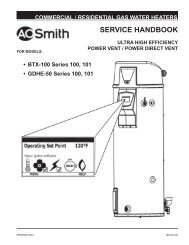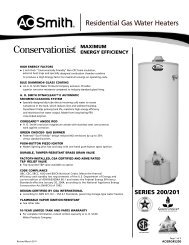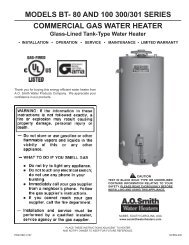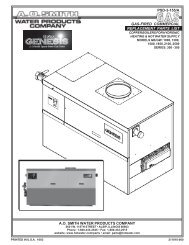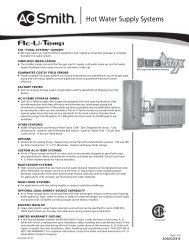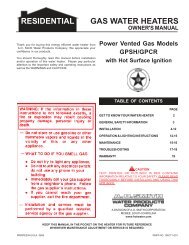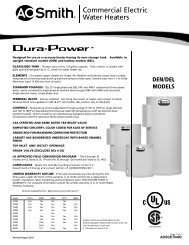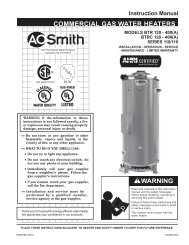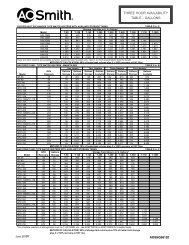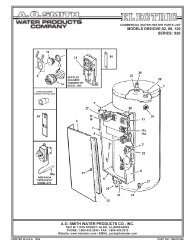Non-Condensing Models - AO Smith Water Heaters
Non-Condensing Models - AO Smith Water Heaters
Non-Condensing Models - AO Smith Water Heaters
You also want an ePaper? Increase the reach of your titles
YUMPU automatically turns print PDFs into web optimized ePapers that Google loves.
3. NORMAL OPERATIONTroubleshooting GuideBecoming familiar with how a tankless water heater normallyoperates may help to figure out what is wrong with it.Assuming it is properly installed with appropriate gas, water,and electric connections, the following is how it shouldoperate:1) ACTIVATIONa. A hot water tap is opened enough that the flowsensor detects a flow rate through the heater greaterthan the activation point of 0.75 gpm.b. The fan activates after flow is detected.c. The computer checks for any problems with the unitbefore startup.d. Igniter activates. You can hear the buzzing of thespark igniter.e. Main gas valve, proportional valve, and solenoid gasvalves will open. You will hear a deep “clunk clunk”noise.f. Once a flame is detected, the red LED located on thecomputer board will activate.g. In a multi‐heater setup, the controller will activate thenext heater in 2‐4 gpm increments, depending on theset temperature.Figure 2*The purpose of this diagram is to illustrate thetankless water heater design concepts, andmay not be accurate to your models physicaldescription.2) OPERATIONa. The proportional gas valve will modulate based on the amount of hot water demanded and thetemperature rise needed. The fan speed will modulate as well to create an efficient burn.b. You will notice that only partial sections of the burner will be lit. This is normal operation; thereare three sections on the burner assembly, and the computer controls the amount of sectionsneeded based on the flow rate and temperature rise required.3) SHUTDOWNa. The heater will shut down when the water flow rate drops below the deactivation point of0.4 gpm.b. The heater will close the main gas valve and solenoid gas valves, extinguishing the flame.c. When the flame disappears the red LED will turn off.d. The fan will increase in speed to purge the venting of any remaining exhaust gases. The lengthof post‐purge can last up to 1 ½ minutes.e. The heater goes into standby waiting for the process to begin again.5| Page
6| PageTroubleshooting Guide4. INSTALLATION1. Follow all local codes, or in the absence of local codes, follow the most recent edition of theNational Fuel Gas Code: ANSI Z223.1/NFPA 54 in the USA or CAN/CSA B149.1 Natural Gas,Propane Installation Code in Canada.2. All gas water heaters require careful and correct installation to ensure safe and efficientoperation. This manual must be followed exactly. Read the “Safety Guidelines” section in theinstallation manual.3. The manifold gas pressure is preset at the factory. It is computer controlled and should notneed adjustment.4. Maintain proper space for servicing. Install the unit so that it can be connected or removedeasily. Refer to the Clearances Section on p. 8 in the installation manual for proper clearances.5. The water heater must be installed in a location where the proper amount of combustible airwill be available to it at all times without obstructions.6. The electrical connection requires a means of disconnection, to terminate power to the waterheater for servicing and safety purposes.7. Do not install the unit where the exhaust vent is pointing into any opening in a building or wherethe noise may disturb your neighbors. Make sure the vent termination meets the requireddistance by local code from any doorway or opening to prevent exhaust from entering abuilding.8. Particles from flour, aerosols, and other contaminants may clog the air vent or reduce thefunctions of the rotating fan and cause improper burning of the gas. Regularly ensure that thearea around the unit is dust‐ or debris‐free; regular maintenance is recommended for thesetypes of environment.9. If you will be installing the water heater in a contaminated area with a high level of dust, sand,flour, aerosols or other contaminants/chemicals, they can become airborne and enter and buildup within the fan and burner causing damage to the water heater.10. For the Indoor 110 (T‐KJr2‐IN), 310 (T‐K4‐IN), and 510 (T‐D2‐IN) models:• These units may be converted to a direct‐vent (sealed combustion) appliance by installing adirect‐vent conversion kit (Part No. 9007667005) which will bring in all requiredcombustible air from outside the building. When installing the conversion kit, please followall instructions included with the kit.• If the water heater is used as a direct‐vent appliance, the unit requires a 3” intake air pipe.The intake pipe must be sealed airtight. Air supply pipe can be made of ABS, PVC,galvanized steel, corrugated aluminum, corrugated stainless steel or Category III stainlesssteel.• Terminating the venting through a sidewall is recommended for the direct‐vent system.• Running the exhaust vent and the intake pipe parallel is recommended.• Terminating the exhaust and intake on the same wall / surface is recommended.Terminating in the same pressure zone allows for pressure balancing, which preventsnuisance shutdowns. Follow venting clearance guidelines in the installation manual.11. For Outdoor 110 (T‐KJr2‐OS), 310 (T‐K4‐OS), & 510 (T‐D2‐OS):• To be installed outdoors and only in areas with mild, temperate climates.
Troubleshooting Guide5. TROUBLESHOOTING5.1 PRELIMINARY CHECKLISTCheck all of these basic items before proceeding onto any other section:• GAS/WATER/ELECTRIC:o The gas supply valve should be fully open.o Verify the correct gas type is being used, NG or LP.o The water supply valve should be fully open.o The unit should be connected to a 120 VAC 60 Hz power supply. This can be verified byobserving the computer board 3‐digit LED display. If it is not lit, the computer board isnot being powered. Check to see if the ON/OFF switch below the fuse box is set to theon position, or if the fuse in the fuse box is blown.• REMOTE: If you are using a remote controller, the remote’s power button must be turned on.• HIGH ALTITUDE: Is your location at an altitude of over 3000 feet? This may cause a lack of air.See the high altitude procedure in the Troubleshooting Procedures section.• HARD WATER: What is the hardness of the water? A softener is always recommended, but ifthe water is above 7 grains of hardness or 70‐140ppm, one must be installed. If there is nowater softener installed, existing installations will gradually accumulate scale buildup on theheat exchanger and cause a leak. Heat exchanger failures do to hard water scale are notcovered under the warranty.• NEW INSTALLATIONS: Is this installation a few years old or brand new?o A unit that has worked properly for a while but is now struggling may have becomescaled up or contains a dirty burner.o A new installation most likely is installed or plumbed incorrectly.• EXTERNAL PROBLEM: Test whether the problem is within the unit or external to the unit (i.e. inthe plumbing system) by attempting to run hot water locally through the pressure relief valve(PRV).oDoes the heater ignite and remain running properly? Or does the heater shut down intoan error code? If it runs fine through the PRV the plumbing system is at fault.NEXT STEP: Finally, check to see if the unit has an error code. The error code will be displayed on theseven segment LED on the bottom left of the computer board. See figures 4 and 5.• If it is displaying an error code, proceed to the Error Codes section (p. 12).• If there is no error code, proceed to the General Problems section (p. 8).7| Page
Troubleshooting Guide5.2 TROUBLESHOOTING ‐ GENERAL PROBLEMSProceed to the Error Codes section if an error code is identified. For other common problems that donot involve an error code, see if the following items help: The water is not hot enough. The water is too hot. Temperature fluctuates when a fixture is opened. Unit does not ignite when water goes through it. It takes a long time to get hot water at the fixtures. The fan motor is still spinning after operation has stopped. Abnormal sounds come from the unit. Loss of pressure at all sinks when the dishwasher fills. Unit has power, gas, and water but does not turn on. Multiple Heater Setup (Easy‐Link)THE WATER IS NOT HOT ENOUGH• Compare the flow and temperature at the pressure relief valve.o If the temperature and flow rate are correct at the PRV then the problem resides in theplumbing line, not in the tankless unit. Check for a cross connection or other water lineproblems• Test the hot water temperature with a handheld thermometer to measure how far off the watertemperature is from the set temperature.o The set temperature may be set too low. The temperature can be changed with thepushbuttons on the PCB or by the remote temperature controller, if one is installed.• Check for cross plumbing between cold water lines and hot water lines. See the Proceduressection (p. 21) for instructions.• Unit may be hard water scaled. The scale acts as an insulator preventing the heat exchangerfrom transferring heat to the water. Contact a Takagi Service Agent.• The unit may not be receiving enough gas.o The gas supply valve may not be fully open.o The gas line may be sized improperly.o The gas supply pressure may be too low. This may be caused by a malfunctioning gassupply regulator, so check to see if your regulator is working properly.• Check to see that a check valve is installed between the pump discharge and the connection tothe cold water supply. Inspect the check valve for proper operation. If there isn’t one installed,or if it is malfunctioning, cold water may be back‐feeding into the system.• Double‐check for a 101 error code. A 101 error code will reduce the amount of gas input intothe heater.• Output temperature will be affected if air flow is impeded.o Check construction dust and debris in venting, such as dry wall.o If there is dust inside the cabinet, there will also be dust inside the burner and heatexchanger. See the procedure for cleaning the burner (p. 26).THE WATER IS TOO HOT• The set temperature may be set too high. The temperature can be changed with dipswitches onthe PCB or by the remote temperature controller, if one is installed.8| Page
Troubleshooting Guide• The flow adjustment valve could be obstructed due to hard water scale or debris, causing lowerthan expected water flow. Verify water flow with a graduated container or with the remotetemperature controller, if one is installed.• The output thermistor could be compromised. This component may be checked by entering theDiagnostics Mode on a remote controller, if one is installed. Turn power off to the unit and runcold water through it; check to see if the inlet and outlet temperatures read the same on theremote. For instructions on how to do this, refer to the Maintenance Sheet, packaged withevery water heater and located behind the front panel of the unit.TEMPERATURE FLUCTUATES WHEN A FIXTURE IS OPENED• Make sure the unit is installed properly using the Proper Installation section (p. 6) of this guide.• Check the flow and temperature right at the unit at the pressure relief valve. If the flow rateand temperature are correct at the PRV, then the problem resides elsewhere in the plumbingline. The following could be plumbing line problems:o Check for cross plumbing between cold water lines and hot water lines. See theProcedures section (p. 21) for instructions.o Check to see that a check valve is installed between the pump discharge and theconnection to the cold water supply. Inspect the check valve for proper operation. Ifthere isn’t one installed, or if it is malfunctioning, cold water may be back‐feeding intothe system.o Problems with a recirculation system:• Check that a check valve is installed between the pump discharge and theconnection to the cold water supply.• Check to see if the pump is operating properly.• Check for air cavitation. The pump will be very hot or chattering.• Check the directional indicator on the pump flange.• Check the sizing of the pump – a minimum flow of 2 gpm is required.• Check gas supplyo Verify the gas supply lines are sized for the maximum Btu/h demand, as indicated in theProper Installation section (p. 6) of this guide (See the specification page p.3 at thebeginning of this manual for gas input rating).o For LP models, there may not be enough gas left in the propane tank.o Verify that the supply gas pressure is within specification, not only when the heater is instandby, but while the heater is running on maximum fire as well. This may be causedby a malfunctioning gas supply regulator.• Ventingo Verify that the exhaust venting is installed to manufacturer’s specification.o Verify that the vent run does not exceed the maximum limit (50 ft.)• The filter on cold water inlet should be clean; look for signs of hard water scaling.• Check to make sure that the clear tube between the proportional gas valve and the bottom ofthe combustion chamber is connected.• On well systems or even on some city water systems, water pressure fluctuations (especially onlow flow) of 8 to 10 psi will result in flow rate fluctuations, which will in turn result in minortemperature fluctuations.• Flow sensor or water control valve may be compromised. Contact the Technical Department.9| Page
Troubleshooting GuideUNIT DOES NOT IGNITE WHEN WATER GOES THROUGH IT• Is the flow rate over 0.75 gpm? See if the unit initiates when you increase demand of waterbeing drawn through the unit (e.g. opening up more hot fixtures).• Check that the gas line is open and is purged of air (p. 22).• Check that the filter on the cold water inlet is clean (p. 21).• Check for reverse connection and cross connection (p. 21).• Problems with recirculation systemo See that a check valve is installed between the pump discharge and the connection tothe cold water supply. A malfunctioning or missing check valve will cause cold water toback‐feed into the system.• If you use the remote controller, is the remote power button turned on?• Check to see if the Computer board is receiving power. This can be verified by observing thecomputer board red LED.o If it is not lit, the computer board is not being powered. Check to see if the ON/OFFswitch below the fuse box is set to the on position, or if the fuse in the fuse box isblown.• If the fan does not initiate at all and it is verified that the unit is powered(see above), the flowsensor may not be working properly. Check the flow sensor for proper impeller functionality.IT TAKES A LONG TIME TO GET HOT WATER AT THE FIXTURES• The time it takes to deliver hot water to your fixtures depends on the length of piping betweenthe two. The longer the distance or the bigger the pipes, the longer it will take to get hot water.If this is the case and you would like to receive hot water to your fixtures quicker, you may wantto consider a hot water recirculation system.• Problems with the recirculation system.o See that a check valve is installed between the pump discharge and the connection tothe cold water supply. A malfunctioning or missing check valve will cause cold water toback‐feed into the system.THE FAN MOTOR IS STILL SPINNING AFTER OPERATION HAS STOPPED• This is normal. After operation has stopped, the fan motor keeps runningfrom 5 to 50 seconds in order to re‐ignite quickly, as well as purge all theexhaust gas out of the flue.ABNORMAL SOUNDS COME FROM THE UNIT• Check the fan for debris.• Contact the Technical Service Department.Figure 3LOSS OF PRESSURE AT ALL SINKS DURING COMMERCIAL DISHWASHER FILLS• Verify the capacity of the heater(s) versus the GPM demand of the dishwasher.• Check the size of the supply lines to the dishwasher.• Look for a water regulator on the dishwasher. Check the dishwasher rating plate to confirm therecommended supply water pressure.• Unit may be hard water scaled. Scale can reduce pressure and flow of water through the unit;this can occur as quickly as a few months.10| Page
Troubleshooting GuideUNIT HAS POWER, GAS, AND WATER BUT DOES NOT TURN ON• For new unit installs, check to make sure the unit is not plumbed in backwards.o Shut off cold water feed only.o Open nearest hot water tap. <strong>Water</strong> flow should stop. If not there is a cold water crossconnection.o Open Pressure Relief Valve. <strong>Water</strong> flow should stop. If not unit is plumbed inbackwards.• Clean the filter (p. 21).• If the fan never initiates, check for a fouled water flow sensor (p. 31).EASY‐LINK SYSTEM SETUP (MULTIPLE HEATER SETUP)• Refer to the Installation Manual for proper setup.• Unit Numberingo The master unit will always be assigned number 1. The remaining units will be randomlyassigned numbers 2‐4 (if there are 4 units in the Easy‐Link system).11| Page
5.3 TROUBLESHOOTING ‐ ERROR CODESTroubleshooting Guide• All units are self diagnostic for safety and convenience when trouble shooting.• If there is a problem with the installation or the unit, it will display a numerical error code onthe Remote Controller (if installed), on the 7‐Seg LED on the computer board (510 (T‐D2)), orthe flashing red LED (110 (T‐KJr2), 310 (T‐K4)) to communicate the source of the problem.• Consult the following chart for the cause of each error code.Table 2 – Error CodesError Code Error Code Error Code510 (T‐D2) 110 (T‐ Red LEDMalfunction Description7‐Seg LED, KJr2), 310 110 (T‐KJr2),remote (T‐K4) 310 (T‐K4)RemoteTM‐RE30 (Optional)031 03 1 Incorrect Dipswitch Settings101 10 5 Warning for 991 Error Code111 11 3 Ignition Failure121 12 3 Flame Loss311 31 2 Output Thermistor321 32 2 Inlet Thermistor331 N/A N/A Mixing Thermistor391 39 2 Air‐fuel Ratio Rod Failure441 N/A N/A Flow Sensor (Easy‐Link System only)510 51 6 Abnormal Gas ValvesN/A 55 6 Abnormal Solenoid Gas Valve611 61 4 Abnormal Fan Motor651 N/A N/A Abnormal Flow Adjustment Valve ( Easy‐Link System only)701 70 1 Computer Board Fault721 72 6 False Flame Detection741 74 N/A Remote Controller Communication Failure761 N/A N/A Communication Failure (Easy‐Link System only)991 99 5 Abnormal combustionRed LED7‐Seg LEDError code on thecomputer boardError code onthe TK‐RE02Error code on thecomputer boardError code onthe TM‐RE30Figure 4 – 310 (T‐K4), 110 (T‐KJr2) Error Code outputsFigure 5 – 510 (T‐D2) Error Code outputs12| Page
Troubleshooting GuideERROR CODE 031 [510 (T‐D2)], ONE FLASH/03 [110 (T‐KJR2), 310 (T‐K4)]INCORRECT DIPSWITCH SETTINGS1) Turn off the power supply.2) Remove front cover and locate the dipswitches on the center of the computer board.3) Check the dipswitch settings on the left and right banks. Refer to p.19 for the correct dipswitchpositions.a. Gas type is a common dipswitch error.b. Most other switches should be on default setting UNLESS the particular setup requiresotherwise.c. Easy‐Link systems: The master heater shall have the number 10 dipswitch on the right bank inthe ON position (left). The remaining heaters (the slave heaters) will have the number 10dipswitch in the OFF position (right) and the communication wires will be attached to the slavein/out plugs.ERROR CODE 101[510 (T‐D2)], FIVE FLASHES/10 [110 (T‐KJR2), 310 (T‐K4)]ABNORMAL COMBUSTION1) Blockage in the airway. Check the following areas:a. Venting length obstruction (Birds’ nests, trash, etc.)b. Backflow preventer installed backwardsc. Heat exchangerd. Fan2) Check the manifold pressure (p. 22). Adjust the manifold pressure to the correct values if necessary.3) If intake air is contaminated with dust, lint (laundry machine nearby), grease (kitchens), or othercontaminants, clean the burner. See p. 26 on procedures for cleaning the burner & rod assembly.4) Weather related issues: high winds, frozen vent termination flap, etc.5) Installations at altitudes around or over 3000 feet: Change dipswitches on the computer board forFM+ modes. See dipswitch explanations on page 19.6) Make sure all dipswitches are set properly for the type of installation.7) If the cause of the 101 error code has been determined and solved, reset the computer board toclear the error code (p. 23).ERROR CODE 111 [510 (T‐D2)], THREE FLASHES/11 (110 [T‐KJR2), 310 (T‐K4)]IGNITION FAILUREHeater does not fire after three failed attempts at ignition.1) Verify that the hi‐limit switch is not tripped. Turn thepower off to the unit. Push the white button in. Theswitch will reset when you hear and feel the button click.Turn the power back on and test the heater. If the unitfires on, the cause of the hi‐limit trip must be determined.Please contact the Technical Service Department forfurther technical support.2) Check the gas supply. Verify that sufficient gas is beingsupplied to the heater and the gas line is clear of debris orany air. Purge the line of air if needed (p. 22).a. It is possible there is a faulty pressure regulator at the13| PageFigure 6
Troubleshooting Guidegas meter.b. For propane units, colder periods of the day result in a cold regulator and may cause thisproblem.3) Verify that the gas supply pressure is within specifications when the heater is in standby and whenthe heater is running.4) Check that the clear plastic tube connecting the proportional gas valve to the combustion chamberis attached.5) The overheat cutoff fuse (OHCF) may have been compromised. For procedures on how to checkwhether the OHCF is intact, refer to p. 24. If the OHCF has been compromised, contact theTechnical Service Department for further assistance.6) If flame comes on for only 1‐2 seconds before going out, clean the flame sensor (p. 25).7) Check the igniter for a spark. The spark may be viewed through the sight glass located next to theigniter and flame sensor.a. A strong blue spark will remain steady and in place, while a weak spark will jump around.b. If no spark or a weak spark is observed, check the igniter wire connections and make sure theseare secure. If these are secure, a replacement igniter will be required.8) Check for blockages in the venting, such as bird nests, animals, or trash.a. PC Board fault or Gas Solenoid fault. Contact the Technical Service Department.ERROR CODE 121 [510 (T‐D2)], THREE FLASHES/12 [110 (T‐KJR2), 310 (T‐K4)]FLAME LOSSThis error code appears if the flames disappear while the unit is still supposed to be in operation.1) Verify that the hi‐limit switch is not tripped. Turn the power off to the unit. Push the white buttonin. The switch will reset when you hear and feel the button click. Turn the power back on and testthe heater. If the unit fires on, the cause of the hi‐limit trip must be determined. Please contact theTechnical Service Department for further technical support.2) Check the gas supply. Verify that sufficient gas is being supplied to the heater and the gas line iscleared of debris.a. It is possible there is a faulty pressure regulator at the gas meter.b. For propane units, colder periods of the day result in a cold regulator and may cause thisproblem.3) Verify that the gas supply pressure is withinspecifications when the heater is in standby and whenthe heater is running.4) Check that the clear plastic tube connecting theproportional gas valve to the combustion chamber isattached.5) If the flame comes on for 1‐2 seconds but then goesout, clean the flame sensor (p. 25).6) The overheat cutoff fuse may have beencompromised. For procedures on how to checkwhether the OHCF is intact, refer to p. 24. If it has,contact the Technical Service Department for furtherassistance.Figure 77) Check for blockages in venting, such as bird nests, animals, or trash.8) PC Board fault or Gas Solenoid fault.a. If one of these is suspected to be the problem, contact the Technical Service Department.14| Page
Troubleshooting GuideERROR CODE 311 [510 (T‐D2)], TWO FLASHES/31 [110 (T‐KJR2), 310 (T‐K4)]OUTPUT THERMISTOR1) Check that the wire connections are secure and free of burnsor cuts. The output thermistor is located on the heatexchanger on the right side.2) Check the resistance value; it should be about 9.0kΩ at roomtemperature (about 74°F).3) Clean the thermistor.a. Drain the unit of water. See p. 21.b. Remove the fastener holding the output thermistor andpull out the sensor probe. Clean the probe to a silverfinish. Do not lose the rubber o‐ring that wraps aroundthis sensor.c. Replace and test.4) If the error code persists, replace the thermistor.Figure 8ERROR CODE 321 [510 (T‐D2)], TWO FLASHES/32 [110 (T‐KJR2), 310 (T‐K4)]INLET THERMISTOR1) Check that the wire connections are secure and free of burns or cuts. The inlet thermistor isembedded in the water inlet connection.2) Check the resistance value; it should be about 9.0kΩ at room temperature (about 74°F).3) Clean the thermistor.a. Drain the unit of water. See p. 21.b. Remove the computer board to access the inlet thermistor. The computer is fixed in place by asingle screw at the top of the board.c. Remove the screw, pull out the sensor probe. Clean the probe to a silver finish. Do not lose therubber o‐ring that wraps around thissensor.d. Replace and test.4) If the error code persists, replace thethermistor.ERROR CODE 331 [510 (T‐D2)]MIXING THERMISTOR1) Check that the wire connections are secureFigure 9and free of burns or cuts. The mixingthermistor is embedded in the water outlet connection.2) Check the resistance value; it should be about 9.0kΩ at room temperature (about 74°F).3) Clean the thermistor.a. Drain the unit of water. See p. 21.b. Remove the computer board to access the mixing thermistor. The computer is fixed in place bya single screw at the top of the board.c. Remove the screw, pull out the sensor probe. Clean the probe to a silver finish. Do not lose thered rubber o‐ring that wraps around this sensor.d. Replace and test.4) If the error code persists, replace the thermistor.15| Page
ERROR CODE 391 [510 (T‐D2)], TWO FLASHES/39 [110 (T‐KJR2), 310 (T‐K4)]AIR‐FUEL RATIO ROD FAILURE1) Check that the wire connections are secure and free ofburns or cuts.2) Check that the clear plastic tube connecting theproportional gas valve to the combustion chamber isattached.3) Clean the AFR (p. 25).ERROR CODE 441 [510 (T‐D2)]Figure 10FLOW SENSORPart of an Easy‐Link system (510 (T‐D2) only), the master unitsignaled for an additional heater to activate and it did not.1) Verify that water is being supplied to the heater in error.2) Verify that the wires are connected to the computer board.3) Check the inlet filter for any debris. See p. 21.4) Check the flow sensor for debris.Troubleshooting GuideERROR CODE 510[510 (T‐D2)], SIX FLASHES/51 [110 (T‐KJR2), 310 (T‐K4)]ABNORMAL GAS VALVESDriving circuit fault for the main or solenoid gas valves.1) If the hot water is shut off, but flamesare still visible through the sight glass,immediately shut off gas and power tothe unit and contact the TechnicalService Department.2) Check the wire connections to the gasvalve assembly for burns or cuts.3) If the unit was recently rebuilt, makesure that each gas valve wire is pluggedinto the proper place.4) Verify that the supply gas pressure iswithin the specified limits. Too high ofan inlet gas pressure may cause theFigure 12main gas valve to jam or could be damaged.Figure 11ERROR CODE SIX FLASHES/55 [110 (T‐KJR2), 310 (T‐K4)]ABNORMAL SOLENOID GAS VALVEDriving circuit fault for the solenoid gas valve.1) If the hot water is shut off, but flames are still visible through the burner sight window, immediatelyshut off gas and power to the unit and contact the Technical Service Department.2) Check the wire connections to the gas valve assembly for burns or cuts.3) If the unit was recently rebuilt, make sure that each gas valve wire is plugged into the proper place.4) Verify that the supply gas pressure is within the specified limits. Too high of an inlet gas pressuremay cause the main gas valve to jam or could be damaged.16| Page
Troubleshooting GuideERROR CODE 611 [510 (T‐D2)], FOUR FLASHES/61 [110 (T‐KJR2), 310 (T‐K4)]ABNORMAL FAN MOTOR1) Turn off power supply.2) Check fan motor wiring for any breakages, burn marks on the PC board, or moisture. If moisture isfound, allow connection to completely dry before turning power back on.3) Check fan housing for water. If found, please dry the fan, then test heater.4) To remove the fan motor.a. Turn off the power supply.b. Move the computer board out of the way.c. Locate the two Phillips head screws fitted at the top ofthe fan motor to the combustion chamber box. Twoholes are located directly at the bottom of the case thatline up with the two screws. Using an 8” screwdriver,remove the screws.d. Slide the fan out towards the left.e. If signs of water are evident, water may have damagedthe fan motor requiring replacement.Figure 135) If the 611 error code still appears after all items have been checked, the PCB may need replacementERROR CODE 651 [510 (T‐D2)]ABNORMAL FLOW ADJUSTMENT VALVE1) Turn off power supply.2) Check that all wire connections are secure and free ofburns. The flow adjustment valve is located behind thecomputer board and attached to the cold water inlet.3) Check for water leakage from the valve.4) Do a visual inspection of the PCB. Check forconnection/breakage of wires and/or burn marks on theboard. PCB may need to be replaced.5) The flow adjustment valve may need to be cleaned. Toremove, follow the steps below:a. Remove the four waterway clips on each side of the Figure 14valves.b. Slide the valve up off the inlet water connection.c. Check both ends of the valve for sediment or debris. Use a brush or descaling solution toremove the sediment.d. Re‐install the valve and clips.e. Test the heater.6) The flow adjustment valve may need to be replaced if the valve cannot be cleaned.ERROR CODE 701 [510 (T‐D2)], ONE FLASH/70 [110 (T‐KJR2), 310 (T‐K4)]COMPUTER BOARD FAULT1) Turn off the power supply.2) Check all wire connections and make sure they are secure and free of burns or cuts.3) Inspect the PCB for connection/breakage of wires and/or burn marks on the board.4) Verify that supply gas pressure is within specifications.5) Contact the Technical Service Department for further assistance.17| Page
Troubleshooting GuideERROR CODE 721 [510 (T‐D2)], SIX FLASHES/72 [110 (T‐KJR2), 310 (T‐K4)]FALSE FLAME DETECTION1) First and foremost, shut off all gas and power to the unit. The problem could be the flame sensor,but if it isn’t, this is a very dangerous situation.2) Contact the Technical Service Department for further assistance.ERROR CODE 741 [510 (T‐D2)], 74 [110 (T‐KJR2), 310 (T‐K4)]MAIN REMOTE CONTROL PROBLEMThis error code only occurs when there is a miscommunication between the temperature remotecontroller and the water heater.1) Check that all wiring is properly connected to the remote.2) Verify the correct model of remote is being used for the corresponding tankless model.3) Verify that only a remote is installed. Multiple remotes will result in this error code.4) If you disconnect the remote from the heater with the power supply on, this error code will result.Turn off power before disconnecting the remote from the heater.5) Check for any signs of power surges.ERROR CODE 761 [510 (T‐D2)]COMMUNICATION FAILURE1) This error code only occurs in a multiple heater setup, where there is a miscommunication betweenmaster and slave units for Easy‐Link systems.2) This error code will only be displayed on the master heater.3) This error indicates that the master unit has lost communication with the indicated heater.4) Verify that there is power to the unit that has lost communication.5) See the Installation Manual for proper communication cable setup.6) Check for signs of power surges.ERROR CODE 991 [510 (T‐D2)], FIVE FLASHES/99 [110 (T‐KJR2), 310 (T‐K4)]ABNORMAL COMBUSTION1) Refer to error code 101.2) Contact the Technical Service Department for further assistance if nothing has worked so far. Themanifold gas pressure may need adjustment.3) If you are sure that the problem has been solved, reset the computer (p. 23).18| Page
Troubleshooting Guide5.4 TROUBLESHOOTING ‐ PROCEDURESVerifying proper Dipswitch settings… p.19Draining the unit………………………………p.21Cleaning the filter…………………………….p.21Checking for a Cross Connection………p.21Check for Reverse Connection………….p.21Check gas supply pressure………………. p.21Purge the gas line of air………………….. p.22Adjusting manifold pressure…………….p.22Resetting the computer board………… p.23Checking the OHCF…………………………. p.24Figure 15VERIFYING PROPER DIPSWITCH SETTINGS:• Incorrect Dipswitch settings can cause a 031 error code, or a number of operational problems.Table 3 – 310 (T‐K4), 110 (T‐KJr2) Dipswitch SettingsNo. Function ON position OFF position1 Gas type Propane Disable2 Natural Gas Disable34FM+, FM++, FM+++ 110 Indoor (T‐KJr2‐IN), 310 Indoor (T‐K4‐IN)No.3OF position N positionNo.4 OFF position 0% +6%ON position +12% +18%110 Outdoor (T‐KJr2‐OS), 310 Outdoor (T‐K4‐OS)No.3OFF positionDipswitch BankON positionNo.4 OFF position 0% +4%ON position +8% +12%5 N/A N/A N/A (Default)6 Model type Outdoor 110 (T‐KJr2‐OS),Outdoor 310 (T‐K4‐OS)Indoor 110 (T‐KJr2‐IN),Indoor 310 (T‐K4‐IN)7 Output temperature settings (Default 122F)819| Page
Troubleshooting GuideUpper bank of dipswitchesLower bank of dipswitchesFigure 16Table 4 – 510 (T‐D2) Dipswitch Settings: UPPER BANKNo. Function ON position OFF position1 Gas type Propane Disable2 Natural Gas Disable3 Allow adjustments of fan motor speed Enable Disable (Default)45FM+, FM++, FM+++ Indoor 510 (T‐D2‐IN)No.4OFF position ON positionNo.5 OFF position 0% +6%ON position +12% +18%Outdoor 510 (T‐D2‐OS)No.4OFF positionON positionNo.5 OFF position 0% +4%ON position +8% +12%6 N/A N/A N/A (Default)Table 5.4 ‐ 510 (T‐D2) Dipswitch Settings: LOWER BANKNo. Function ON position OFF position1 Parent/Child setting for Easy‐Link systems Parent Child (Default)2 Model type Indoor 510 (T‐D2‐IN) Disable(Default)3 Outdoor 510 (T‐D2‐OS) Disable(Default)4 Output temperature settings (Default 122˚F)5620| Page
21| PageTroubleshooting GuideDRAINING THE UNIT:1) Close the manual gas shut off valve.2) Turn off power to the unit, and then turn on again.3) Wait 30 seconds, and then turn off power to the unit, yet again.4) Close the cold water inlet shutoff valve.5) Open all hot water taps in the house, or open the pressure‐relief valve to remove the initialpressure. When the residual water flow has ceased, close all hot water taps.6) Unscrew the drain plugs (hot water outlet drain plug and cold water inlet filter) to drain theremaining water out of the unit. Have a bucket or pan to catch the water from the unit’sdrain plugs. Wait a few minutes to ensure all water has completely drained from unit.CLEANING THE FILTER:1) Drain the unit (procedure above).2) Check the water filter located within thecold inlet. With a tiny brush, clean thewater filter of any debris which mayhave accumulated and reinsert the filterback into the cold water inlet.3) Securely screw the filter back into place.Hand‐tighten only.Figure 17CHECKING FOR A CROSS CONNECTION:1) Turn off cold water supply.2) Turn on all hot water fixtures.a. The water should eventually completely drain.b. If water continues to run, the fixtures and plumbing system needs to be checked.c. Cold water cross connections may be related to a recirculation pump application, abad check valve, or missing check valve in the application.CHECK FOR REVERSE CONNECTION:1) Close cold water supply at the inlet.2) Open the pressure‐relief valve; it should be installed on the hot side outlet of the unit.3) If water continues to run through the pressure‐relief valve, the system has a reverseconnection.CHECK GAS SUPPLY PRESSURE:1) Close the manual gas inlet shut off valveon the gas supply line.2) Open a faucet. The unit should turn onand the gas in the pipe line should purge.Leave the faucet on to keep the unitrunning until it shuts down due to lack ofgas, and then shut the faucet off. Ignoreany error codes that may occur at thistime.Figure 183) Remove the screw for the pressure portlocated on the gas inlet shown on the right.4) Connect a manometer to the pressure port.
Troubleshooting Guide5) Slowly re‐open the manual gas valve. Check to see that there are no gas leaks.6) Open some of the fixtures that use the highest flow rate to activate.7) Check the inlet gas pressure. Appropriate pressures are listed in the specification page atthe front of this manual.PURGE THE GAS LINE OF AIR:1) The unit should not be running during this procedure. Turn off power to the unit.2) Turn the gas valve to the off position (perpendicular to the gas line).3) Loosen the gas line on the unit side of the gas valve (at a flare fitting or union).4) Next open the gas valve very slightly until you can smell gas by wafting the air towards yournose. This means any air previously in the gas line has been removed and only gas remains.5) Turn gas back off and re‐tighten gas line.6) Turn gas back on and check for leaks. Spray water & dish soap mixture onto fittings. Nobubbles means there are no leaks.CHECKING MANIFOLD GAS PRESSURE:1) Ensure the unit is not in operation.2) Remove the screw off the manifold port.3) Connect a manometer to the manifold port usinga tube (Figure 1). Ensure that this connection issecure enough to prevent gas leak.4) Run water through the unit to activate itsoperation. It is suggested that a large amount offlow is drawn in order to prevent overheatingduring max burn. If presence of a gas leak isdetected, immediately shut off the unit and Figure 19inspect the tube/manifold connection; otherwise,proceed onto the next step.5) To check the manifold gas pressure during maximum combustion, press and hold the “MAX”button on the computer board. To check the manifold pressure during minimumcombustion, press and hold the “MIN” button on the computer board. The desiredpressures are listed in the specification table at the beginning of this manual.6) If the manifold pressures do not match up with those listed, adjust the manifold pressure(see the following procedure).22| Page
Troubleshooting GuideADJUSTING MANIFOLD PRESSURE:The manifold gas pressure of the tankless unit can be adjusted by the following procedure.WARNINGAdjusting the manifold pressure can cause unexpected combustion conditions duringoperation, which can cause a health hazard, damage the tankless unit, and or shorten itslifespan. Therefore, changing the manifold pressure is not recommended unless thereare very strong reasons to do so (e.g. high elevation installations), and with theconsultation of the Technical Service Department.1) Set up the manometer by following steps 1 through 4 on the “Checking manifold gaspressure” procedures on p. 21.2) Press and hold down the “MIN” buttonon the computer board. While holdingdown the “MIN” button, press either the“INCREASE” or “DECREASE” button toincrease or decrease the manifold gaspressure, respectively (Figure 5.18).Refer to the manometer to verify thatpressure has been set to desired value.3) Now press and hold down the “MAX”button on the computer board to changethe maximum burn pressure.4) Repeatedly adjust the minimum andmaximum pressures again until bothlevels are stable and there are no more changes from the previous iteration.5) After the manifold gas pressure has been set, deactivate the unit (stop all water runningthrough the unit), remove the manometer tube, and replace the port screw.MAXMINIncreaseDecreaseFigure 20Computer boardRESETTING THE COMPUTER BOARD:1) Verify that there is no water flowing throughthe unit.2) If a temperature remote controller has beeninstalled, turn the power off to the remote.3) Turn off power to the unit, and then turn onagain.4) Push and hold the “INC” and “DEC” buttonson the computer board simultaneously forseveral seconds until the red LED lights upsolid.5) Use the Power ON‐OFF switch/GFI to turn theunit off then on again. The computer board isreset.Figure 2123| Page
Troubleshooting GuideCHECKING THE OVERHEAT CUTOFF FUSE (OHCF):1) Locate the white OHCF which wraps aroundthe heat exchanger.2) Find the white clip at the end of the two bluebraided wires coming from the OHCF.3) Unplug the connection.4) Test for continuity at the end of the OHCFwith an ohmmeter. If there is continuity, theOHCF is still intact. Reconnect the plug. Ifthere is no continuity, the OHCF has beencompromised. If compromised, contact theTechnical Service Department for furtherassistance.Figure 225) If an ohmmeter is not available, jump the plug connection on the opposite side of the OHCFwith a wire, paper clip, or other metal material.6) Restore power and test unit. Be very cautious with this step. Do not touch the jumper orother electrical components.7) If the unit fires up, it shows that the OHCF has been compromised and the problem was withthe OHCF. If so, contact the Technical Service Department for further assistance. If the unitdoes not fire up, it shows that the cause of the 111 or 121 error code is something else.Continue with the 111 or 121 error code sections of this guide for further troubleshooting.Figure 2324| Page
6. MAINTENANCETroubleshooting GuideBecome familiar with the components before attempting these procedures, utilizing the InstallationManual and referencing the component schematic on the last few pages of the manual.Safety is the most important part of this guide. These procedures must be done by a licensed competenttechnician. A.O. <strong>Smith</strong> is not liable for the actions of the technician if he/she fails to adhere to any or allsafety procedures, specifically in regards to electrical and gas safety.CLEANING THE ROD ASSEMBLY1) TOOLS ‐ Gather the following materials together:a. Sheet of 100 Grit Sandpaperb. #2 Philips Screw Driverc. Flashlight2) POWER ‐ Disconnect power to your unit by either unplugging it from the wall outlet, or by the circuitbreaker, depending on the setup. The 3‐digit LED on the PCB should not be lit.3) FRONT COVER ‐ Remove the front cover. It isheld on by two screws on the top corners of thetankless unit.4) ROD ASSEMBLY –a. Locate the black, yellow, and orange wireslocated in the center of the unit.b. Remove the three Phillips head screwsholding the panel in place.c. Pull the assembly out. Caution, all piecesare separate. Be careful to not lose thesight glass.Figure 245) SENSORS – It is important to be very gentle with the sensors while cleaning them, as they will easilybend out of place. Their original position relative to the burner needs to be unaltered to functionproperly.a. Clean the flame sensor with 100 grit sandpaper, thoroughly to a bright finish.b. Clean the air fuel ratio rod with 100 grit sandpaper, thoroughly to a bright finish.6) REASSEMBLE ‐ Reassemble the unit in reverse order – sight glass, gasket, rods, and metal cover. Keypoints to remember:a. Connect all 3 wires on front of burner.b. Inspect all of the gaskets.25| Page
Troubleshooting GuideCLEANING THE COMBUSTION COMPONENTSProcedure for cleaning the fan, burner, Flame Sensor and AFR, as used by all Service Representatives.1) TOOLS ‐ Gather the following materials together:a. Degreaser in a pump action bottle, Sandpaper, Philips Screw Driver, Needle‐Nosed Pliers, DuctTape, Flashlight, Air Compressor, Shop Vacuum, 3x Towels2) POWER ‐ Disconnect power to your unit by either unplugging it from the wall outlet, or by the circuitbreaker, depending on the setup.3) GAS ‐ Shut off the gas supply.4) FRONT COVER ‐ Remove the front cover.5) MANIFOLD PLATE/GAS VALVE ASSEMBLY ‐a. Remove the manifold plate screws. They are wide pan head Philips screws, located on theedges of the stamped metal plate of the gas manifoldb. Remove the brass gas valve screw.c. Remove the wire holding the Easy‐Link wires in place.d. Disconnect the clear plastic tube from beneath the combustion chambere. Gently lift up the manifold & gas valve assembly to dislodge it from the gas inlet, and gently let ithang.i. There is a small filter screen in the bottom of the gas inlet. Do not lose it.Figure 25Figure 2626| Page
Troubleshooting Guide6) BURNER ASSEMBLY ‐ Now proceed to remove the burner assembly.a. Remove the five wide pan head Philips screws holding the burner to the combustion chamber.There are three at the top of the burner. There are two at the bottom of the burner to the backof the combustion chamber.b. Disconnect the rod assembly: Orange flame sensor, Yellow AFR, Black igniter wirec. Remove the burner. It may be hard to take out, so try the following:i. With pliers, grasp between the oval air vents in the front of the burner on the far left and pullfirmly. Repeat on the right vent.ii. Now pull from the center and it should slide out readily.d. Inspect the gasket. (Minor surface tears are allowable. Major separations are not acceptable.Rod AssemblyFigure 277) CLEAN THE BURNER – Use degreaser in a pump action bottle.a. Protect the burner gasket from direct water pressure.IF the gasket becomes compromised, please contact theTechnical Service Department for further assistance.b. Thoroughly saturate the burner with the cleaning solutionfrom the top, down through the slots, as well as theopenings in the front of the burner until the burner issoaking wet.c. Let the burner sit for 5 minutes.d. Remove the burner from the solution. Set the burner in a Figure 28sink in its normal upright position and wash the burnerwith a high flow of water down into the slots, starting at the back and moving forward. Again,ensure that no contact is made with the gaskets.e. Use compressed air to clear excessive water from the burner after rinsing. Inspect the gasket.(Minor surface tears are allowable. Major separations are not acceptable)8) FAN ‐ The fan is probably coated with dust as well.a. Place a towel at the bottom of the heat exchanger to cover the square port to the fan. Thistowel will catch all the dust blown in the next step.b. Use compressed air to blow into the fan. It will rotate and dust will fly out of the fan housinginto the towel above.27| Page
Troubleshooting Guide9) COMBUSTION CHAMBER ‐ Inspect the combustionchamber with a bright flashlight.a. Remove the exhaust venting from top of the unitfor the DV modelb. Place one towel at the bottom of the combustionchamber, protecting the discharge of the fan (fanport), as well as drape another towel covering thesquare opening of the combustion chamber (toprevent airborne debris)c. Turn on the shop vacuum and vacuum all of the dirtfrom the combustion chamber.d. At the same time, with the air compressor, blow airdown through the top of the heat exchangerFigure 29through the vent collar to remove additional contaminants.10) HEAT EXCHANGER ‐ If there is a white, crusty solid buildup in the heat exchanger, please contact theTechnical Service Department for furtherinstruction.11) SENSORS –a. Clean the flame sensor and AFR withsandpaper, thoroughly to a bright finish.It is important to be very gentile with thesensor rods while cleaning them, as theywill easily bend out of place. Their originalposition relative to the burner needs to beunaltered in order to function properly.12) REASSEMBLE ‐ Reassemble the unit in reverseorder. Key points to remember:Figure 30a. Inspect all of the gaskets.b. Be aware of the black O‐ring and mesh filter on the gas valve inlet.c. Reconnect the plastic tube from the gas valve to the bottom of the combustion chamber.d. Reattach all components that the manifold screws secure in their places.e. Reconnect all wires to the computer board and any other clips.f. Do not have any screws left over.28| Page
Troubleshooting GuideREPLACING THE HEAT EXCHANGERThere are many possible causes of a heat exchanger failure:• Contaminated air with a high level of dust, lint, sand, grease, aerosols or other contaminants,can become airborne and enter the air intake. The contaminants build up within the fan andburner assembly causing abnormal flame conditions due to lack of combustion air, damagingmany components of the unit.• Scale can build up from very hard water. Lime scale will form on the inside of the heatexchanger tubes readily at high temperatures. This scale prohibits heat from reaching the waterwhich causes excessive heat within the heat exchanger copper, and it will eventually burn andleak.Along with changing the heat exchanger, it is important to identify the CAUSE of the need forreplacement, and fix the problem so it does not occur again1) TOOLS ‐ Gather the following materials together:a. Degreaser in a pump action bottleb. Sheet of 100 Grit Sandpaperc. #2 Philips Screw Driverd. Needle‐Nosed Plierse. Duct Tapef. Flashlightg. Air Compressorh. Old Towels, at Least Three2) PREPARE THE UNITa. POWER ‐ Disconnect power to your unit.b. GAS ‐ Shut off the gas supply to the unit.c. WATER – Drain the unit. Refer to p. 21 for instructions.3) REMOVE MANIFOLD/GAS ASSEMBLY, BURNERa. Follow steps 1‐7 of the previous section, “Cleaning the Combustion Components”. This will tellyou how to remove the PCB, manifold/gas assembly, and burner4) WIRES ‐ There are several wire clips that need to be removed to free the heat exchangera. Locate the brown wire clip connected to the GFI, and disconnect it.b. On the bottom left, disconnect the ceramic heating elements (white wires).c. Locate the white bypass valve clip on the left‐hand side of the combustion chamber withred/black wires. Disconnect it.d. Upwards toward the left side, remove a blue connection to the over‐heat cutoff fusee. Remove the two spade connections on the high limit switch.f. Disconnect the igniter plug (purple wires and blue plug) at the bottom right.g. Along the bottom, disconnect the plug into the proportional valve (red & white wires).29| Page
Troubleshooting Guide5) FANa. The fan is held in by two screws. They face the bottom ofthe heater, and can be reached by two holes in the bottomof the case with a long screwdriver.b. Slide it left to release it from the grooves.6) WATERWAYSa. If the unit has not been drained at this point, now is thetime to do so. Refer to the Draining the Unit procedure inthe troubleshooting procedures section.b. Disconnect the waterway clips pictured at the right.c. Place a dry towel in the bottom of the unit case whendislodging the pipes from their sockets.Figure 317) REMOVE THE HEAT EXCHANGERa. Remove the two screws at the top of the heat exchanger.b. The heat exchanger should be free to be removed. Ifthere are any missed wires still connected to the heatexchanger assembly, remove them so the heat exchangeris completely free.8) REPLACE THE HEAT EXCHANGER COMPONENTSa. Remove and inspect the new heat exchanger making sure Figure 32it is designed for the correct model and is notdamaged at all.b. Install the following items from the oldexchanger onto the new one:i. Overheat Cutoff Fuseii. Freeze protection blocksiii. Plastic pressure portiv. Hi‐Limit switchv. Hot water thermistorvi. Silicon Vent GasketFigure 339) REASSEMBLE ‐ Reassemble the unit in reverse order. Key points to remember:a. All wires must be reconnected. Keep wires dangling out in front of the unit, never push themtoward the back where they are not visible; you will forget about them.b. Inspect all of the gaskets.c. Be aware of the various O‐rings on the gas and water valves, along with the waterway clips.d. Reattach all extra components that the manifold screws secure in their places.e. Do not have any screws left over.30| Page
Troubleshooting GuideCHECKING THE FLOW SENSORIf the tankless unit is properly connected to water, gas, and power supplies but the fan motor does notinitiate when water is run through it, the flow sensor is most likely not working properly and not tellingthe PC Board to initiate.1) TOOLS ‐ Gather the following materials together:a. Degreaser in a pump action bottleb. #2 Philips Screw Driverc. Flashlightd. Old Towels, at least three2) PREPARE THE UNIT –a. Drain the unit by following the procedures on p. 21.b. Disconnect power to the unit.3) FRONT COVER ‐ Remove the front cover.4) COMPUTER BOARDa. Remove the screw holding the computer board to themanifold, and let the computer board hang in front of the unitb. Disconnect the flow sensor wire.Figure 345) DISCONNECT FROM WATERWAYa. The flow sensor is located behind the computer board.b. Remove the waterway clips on each side of the flow sensor by pushing on the tabs.6) CHECKING THE FLOW SENSORa. Check for functionality. Flow rate is determined by an impeller that spins as fluid runs throughit.b. Blow into the inlet of the flow sensor. Listen for the spinning impeller; it should spin freely for afew seconds. If it comes to rest abruptly or doesn’t spin at all, it needs to be cleaned orreplaced.c. Place the flow sensor into a container of lemon juice or another degreaser for 30 minutes andcheck the spinning capability again.d. Test the cleaned flow sensor by “jumping” the system:i. Reattach the flow sensor wires.ii. Turn power back on to the unit. (GAS SHOULD STILL BE OFF)iii. Blow into the flow sensor; if the fan initiates, the flow sensor successfully read theairflow and should now work properly.7) REASSEMBLE ‐ Reassemble the unit in reverse order. Ensure that the O‐rings and waterway clips areall in place.31| Page
Troubleshooting GuideDESCALING THE UNITHard water is a severe problem for the copper coils inside heat exchangers. Heat exchangerfailure due to scale buildup from hard water conditions is NOT covered by warranty. It is highlysuggested that a scale inhibitor be installed before the cold water inlet after this procedure isdone.1) TOOLS ‐ Gather the following materials together:a. Pump: The pump should provide a minimum of1GPM through the heaterb. Cleaning Solution: Food grade citric acid, foodgrade phosphorus acid.c. <strong>Water</strong> hosesd. Bucket2) SETUP ‐ Disconnect power to the unit3) WATERLINES – Assumes isolation valves with drainports are installeda. Isolate the unit by closing the incoming/outgoingwater isolation valves C and D.b. Connect hoses/pump to the drain ports of theisolation valves: Outlet of the pump to valve B,and another hose from Valve A to the bucket.4) PUMP –a. Fill the bucket with 5 gallons of diluted solution.Dilution ratio depends on the cleaning solutionused.b. Place the pump into the bucket if it is submersible,or use an inlet hose into the bucket if it is notsubmersible.Figure 355) DESCALEa. Open valves A and B.b. Circulate descaling solution through the unit for 45 minutes.6) CLEANSE THE SYSTEM – Flush the chemicals out of the heat exchanger with fresh water.a. Close valve A and B.b. Open valve D and run fresh water through the PRV for 15 minutes.c. Clean the filter after flushing the unit with fresh water.d. Once the unit is flushed and cleansed, close A and B, open C and D, and reconnect power to theunit.321923‐00032| Page



